Vatican City (/ˈvætᵻkən ˈsɪti/ (About this sound listen);
Italian: Città del Vaticano [tʃitˈta ddel vatiˈkaːno]; Latin: Civitas
Vaticana), officially Vatican City State or the State of Vatican City (Italian:
Stato della Città del Vaticano; Latin: Status Civitatis Vaticanae), is a
country located within the city of Rome. With an area of approximately 44
hectares (110 acres), and a population of 1,000, it is the smallest state in
the world by both area and population. However, formally it is not sovereign,
with sovereignty being held by the Holy See.It is an ecclesiastical or
sacerdotal-monarchical[8] state (a type of theocracy) ruled by the Bishop of
Rome – the Pope. The highest state functionaries are all Catholic clergy of
various national origins. Since the return of the Popes from Avignon in 1377,
they have generally resided at the Apostolic Palace within what is now Vatican
City, although at times residing instead in the Quirinal Palace in Rome or
elsewhere. Vatican City is distinct from the Holy See (Latin: Sancta Sedes),[g]
which dates back to early Christianity and is the main episcopal see of 1.2
billion Latin and Eastern Catholic adherents around the globe. The independent
city-state, on the other hand, came into existence in 1929 by the Lateran
Treaty between the Holy See and Italy, which spoke of it as a new creation, not
as a vestige of the much larger Papal States (756–1870), which had previously
encompassed much of central Italy. According to the terms of the treaty, the
Holy See has "full ownership, exclusive dominion, and sovereign authority
and jurisdiction" over the city-state. Within Vatican City are religious
and cultural sites such as St. Peter's Basilica, the Sistine Chapel and the
Vatican Museums. They feature some of the world's most famous paintings and
sculptures. The unique economy of Vatican City is supported financially by the
sale of postage stamps and tourist mementos, fees for admission to museums, and
the sale of publications. The name Vatican City was first used in the Lateran
Treaty, signed on 11 February 1929, which established the modern city-state.
The name is taken from Vatican Hill, the geographic location of the state.
"Vatican" is derived from the name of an Etruscan settlement, Vatica
or Vaticum meaning garden, located in the general area the Romans called
vaticanus ager, "Vatican territory". The official Italian name of the
city is Città del Vaticano or, more formally, Stato della Città del Vaticano,
meaning "Vatican City State". Although the Holy See (which is
distinct from the Vatican City) and the Catholic Church use Ecclesiastical
Latin in official documents, the Vatican City officially uses Italian. The
Latin name is Status Civitatis Vaticanæ; this is used in official documents by
not just the Holy See, but in most official Church and Papal documents.
The Papal Basilica of St. Peter in the Vatican (Italian:
Basilica Papale di San Pietro in Vaticano), or simply St. Peter's Basilica
(Latin: Basilica Sancti Petri), is an Italian Renaissance church in Vatican
City, the papal enclave within the city of Rome. Designed principally by Donato
Bramante, Michelangelo, Carlo Maderno and Gian Lorenzo Bernini, St. Peter's is
the most renowned work of Renaissance architecture and the largest church in
the world. While it is neither the mother church of the Catholic Church nor the
cathedral of the Diocese of Rome, St. Peter's is regarded as one of the holiest
Catholic shrines. It has been described as "holding a unique position in
the Christian world" and as "the greatest of all churches of
Christendom". Catholic tradition holds that the Basilica is the burial
site of Saint Peter, one of Christ's Apostles and also the first Pope.
Saint Peter's tomb is supposedly directly below the high altar of the Basilica.
For this reason, many Popes have been interred at St. Peter's since the Early
Christian period, and there has been a church on this site since the time of
the Roman emperor Constantine the Great. Construction of the present basilica,
which would replace Old St. Peter's Basilica from the 4th century CE, began on
18 April 1506 and was completed on 18 November 1626. St. Peter's is famous as a
place of pilgrimage and for its liturgical functions. The Pope presides at a
number of liturgies throughout the year, drawing audiences of 15,000 to over
80,000 people, either within the Basilica or the adjoining St. Peter's Square.
St. Peter's has many historical associations, with the Early Christian Church,
the Papacy, the Protestant Reformation and Catholic Counter-reformation and
numerous artists, especially Michelangelo. As a work of architecture, it is
regarded as the greatest building of its age. St. Peter's is one of the four
churches in the world that hold the rank of Major Basilica, all four of which
are in Rome. Contrary to popular misconception, it is not a cathedral because
it is not the seat of a bishop; the Cathedra of the Pope as Bishop of Rome is
in the Archbasilica of St. John Lateran.
The Mausoleum of Hadrian, usually known as Castel
Sant'Angelo (Italian pronunciation: [kaˈstɛl sanˈtandʒelo]; English: Castle of
the Holy Angel), is a towering cylindrical building in Parco Adriano, Rome,
Italy. It was initially commissioned by the Roman Emperor Hadrian as a
mausoleum for himself and his family. The building was later used by the popes
as a fortress and castle, and is now a museum. The Castle was once the tallest
building in Rome. The tomb of the Roman emperor Hadrian, also called Hadrian's
mole, was erected on the right bank of the Tiber, between 134 and 139 AD.
Originally the mausoleum was a decorated cylinder, with a garden top and golden
quadriga. Hadrian's ashes were placed here a year after his death in Baiae in
138, together with those of his wife Sabina, and his first adopted son, Lucius
Aelius, who also died in 138. Following this, the remains of succeeding
emperors were also placed here, the last recorded deposition being Caracalla in
217. The urns containing these ashes were probably placed in what is now known
as the Treasury room deep within the building. Hadrian also built the Pons
Aelius facing straight onto the mausoleum – it still provides a scenic approach
from the center of Rome and the left bank of the Tiber, and is renowned for the
Baroque additions of statues of angels holding aloft instruments of the Passion
of Christ.
The Basilica of Saint Mary in Cosmedin (Italian: Basilica di
Santa Maria in Cosmedin or de Schola Graeca) is a minor basilica church in
Rome, Italy. It is located in the rione of Ripa. The church was built in the
8th century, during the Byzantine Papacy, over the remains of the Templum Herculis
Pompeiani in the Forum Boarium and of the Statio annonae, one of the food
distribution centres of ancient Rome (another is to be found at the Theatre of
Balbus). A deaconry was a place where charitable distributions were given to
the poor, and it is appropriate that such an institution would have been built
near or at a station of the Roman annona. Since it was located near many
Byzantine structures,[according to whom?] in 7th century this church was called
de Schola Graeca, and a close street is still called della Greca. Greek monks
escaping iconoclastic persecutions decorated the church around 782, when pope
Adrian I promoted its reconstruction; the church was built with a nave and two
aisles and a portico. Because of its beauty, the church received the adjective
cosmedin (from Greek kosmidion), ornate. A sacristy and an oratory dedicated to
St. Nicholas were added in the 9th century, by order of Pope Nicholas I, who
also built a papal residence, but they were destroyed in the Sack of Rome
(1084) by Robert Guiscard's Norman troops.
The Mouth of Truth is a marble mask in Rome, Italy, which
stands against the left wall of the portico of the Santa Maria in the Cosmedin
church, at the Piazza della Bocca della Verità, the site of the ancient Forum
Boarium (the ancient cattle market). It attracts visitors who audaciously stick
their hand in the mouth. The massive marble mask weighs about 1300 kg and
probably depicts the face of the sea god Oceanus. The eyes, nostrils and mouth
are open. Historians aren't quite certain what the original purpose of the disc
was. It was possibly used as a drain cover in the nearby Temple of Hercules
Victor, which had an oculus—a round open space in the middle of the roof,
similar to that of the Pantheon. Hence, it could rain inside. It is also
thought that cattle merchants used it to drain the blood of cattle sacrificed
to the god Hercules. In the thirteenth century the disc was probably removed
from the temple and placed against the wall of the Santa Maria in Cosmedin. In
the seventeenth century it eventually moved to its current location inside the
portico of the church.























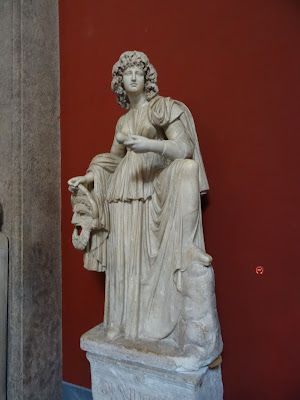








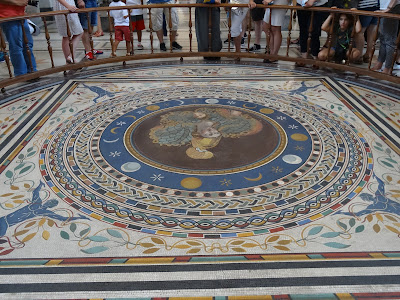





















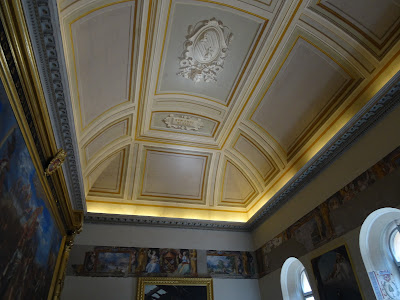























































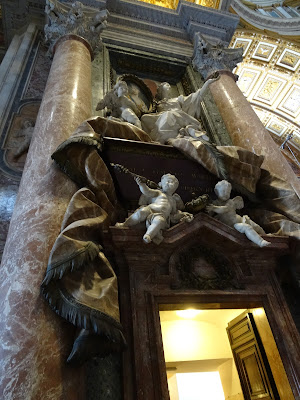






















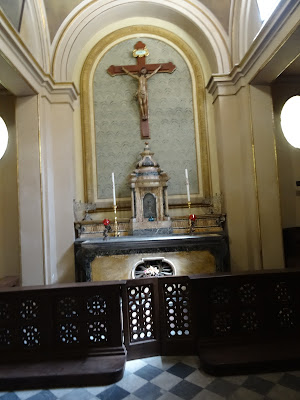





Niciun comentariu:
Trimiteți un comentariu